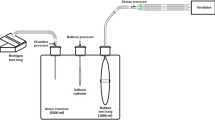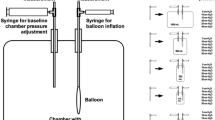Abstract
The goal of our study was to investigate manometric balloon sensors of original conception in order to overcome the limitations of perfused and solid-state sensors in the assessment of the pharyngoesophageal motility abnormalities. A standard perfused probe for esophageal manometry was modified by applying fluid-filled floppy balloons 0.5-, 1-, and 2.5-cm long. The balloon sensor probe was tested at the bench with regard to the response to the applied pressures, the frequency–response curve, and the behavior during propagation of the peristaltic waves in an esophageal model. The physical properties of the balloon sensors proved to be adequate for pharyngoesophageal motility studies. The static response of the balloon probe to the applied pressures was linear. For the frequency–response curve, the upper cutoff frequency (A = 1/√2) was 23 Hz, resonance frequency was 16 Hz, and resonance amplification was 1.6. No statistically significant differences were observed between balloon sensors of different length with regard to amplitude and duration of recorded peristaltic waves (p > 0.05). In conclusion, the balloon probe has the physical and technical characteristics required for the study of swallowing disorders.






Similar content being viewed by others
References
DO Castell (Eds) (1992) The Esophagus. Little, Brown Boston
PJ Kahrilas RE Clouse WJ Hogan (1994) ArticleTitleAmerican Gastroenterological Association technical review on the clinical use of esophageal manometry. Gastroenterology 107 1865–1884 Occurrence Handle1:STN:280:ByqD2cjhslY%3D
J Dent (1976) ArticleTitleA new technique for continuous sphincter pressure measurements. Gastroenterology 71 263–267 Occurrence Handle1:STN:280:CSmB3sngt1E%3D Occurrence Handle939387
F Waldeck HM Jennewein R Siewent B Nieder (1973) Manometric methods for functioned analysis of the lower esophageal sphincter (LE) and the act of swallowing. HR Sorensen O Jepsen SA Pedersen (Eds) Functions of the Esophagus. Odense University Press Odense
F Waldek (1976) The basis of oesophageal manometry. Funktionsstorungen der speiserohre. Springer-Verlag New York 109–118
F Waldek HM Jennewein R Siewert (1974) Manometric methods for measuring rapid pressure changes in the esophagus and its sphincters. Proceedings 4th International Symposium on Gastrointestinal Motility. Mitchell Press Vancouver 449–456
S Mattioli V Felice FG Pearson R Zannol G Gozzetti (1993) ArticleTitleBalloon sensors versus perfused side hole sensors for oesophageal manometry. A study in healthy volunteers. Eur J Gastroenterol Hepatol 5 133–139
S Mattioli R Zannoli V Felice V Pilotti A Lazzari MP Di Simone A Raspadori G Gozzetti (1991 Apr 15) ArticleTitleMonitoraggio della pressione esofagea: confronto con diverse metodiche e proposta di una soluzione originale. Minerva Chir 46 IssueID7 Suppl 11–17 Occurrence Handle1:STN:280:By6B1MnhsFI%3D
CE Code JF Schlegel (1958) ArticleTitleThe pressure profile of the gastro-esophageal sphincter in man: an improved method of detection. Mayo Clin Proc 33 406–414 Occurrence Handle1:STN:280:CyaD38%2FnvVc%3D Occurrence Handle13591399
H Kronecker SJ Meltzer (1883) ArticleTitleDer schlukmechanism, scine erregung und scine hemmung. Arch PF Physiol Lepiz Suppl 338–362
FJ Ingelfinger WO Abbot (1940) ArticleTitleIntubation studies of human small intestine: diagnostic significance of motor disturbances. Am J Dig Dis 7 468–474
JH Linehan J Dent WJ Dodds WJ Hogan (1985) ArticleTitleSleeve device functions as a Starling resistor to record sphincter pressure. Am J Physiol 248 G251–G255 Occurrence Handle1:STN:280:BiqC3Mbmtl0%3D Occurrence Handle3970206
DC Gotley CP Barham R Miller R Arnold D Alderson (1991) ArticleTitleThe sphinctometer: a new device for measurement of lower oesophageal sphincter function. Br J Surg 78 933–935 Occurrence Handle1:STN:280:By2D3cvmsFM%3D Occurrence Handle1913108
NJ Trudgill SA Riley (1999) ArticleTitleMonitoring the lower oesophageal sphincter: sphinctometer or sleeve? Neurogastroenterol Motil 11 173–178 Occurrence Handle1:STN:280:DyaK1M3ot1yjsQ%3D%3D Occurrence Handle10354342
Author information
Authors and Affiliations
Corresponding author
Rights and permissions
About this article
Cite this article
Mattioli, S., Lugaresi, M., Zannoli, R. et al. Balloon Sensors for the Manometric Recording of the Pharyngoesophageal Tract: An Experimental Study . Dysphagia 18, 249–254 (2003). https://doi.org/10.1007/s00455-003-0009-7
Issue Date:
DOI: https://doi.org/10.1007/s00455-003-0009-7




